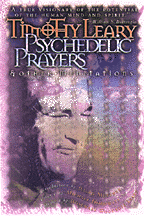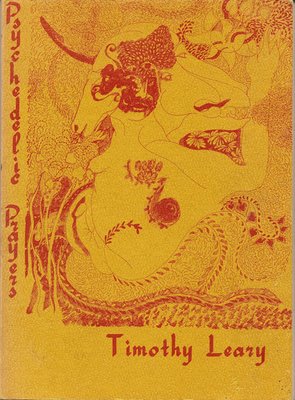

Originally published in 1966, ‘Psychedelic Prayers after
the Tao Te Ching’ by Timothy Leary is a work of textual interpretation,
an exercise in creativity and an attempt to illuminate and guide the
psychedelic experience through the lens of an ancient text. The
cover drawing, a psychedelic, red horse motif, is illustrated by
Michael Bowen.
Having already published ‘The
Psychedelic
Experience: A manual based on the Tibetan Book of the Dead’,
as an LSD guide book, Timothy Leary decided to look further East for
his next inspiration. A fresh framework for exploring the “awareness-of-energy”
and
the “patterns of neurological signals which are usually
censored from mental life.”
The Tao Te Ching is an ancient Chinese text, containing 81
verses. It is thought to date from about the 6th century
B.C.E, and tradition has it that it was written by Lao Tse, which means
“old master”, although the authenticity of authorship and actual dates
are still hotly debated.
The style of the text is poetic and philosophical (in the
broadest sense) and has been used as an inspiration for religions,
artisans and in other systems of thought. There are numerous
translations of the title, however its two root words are usually
translated as “way” and “virtue”. It first became popularized in the
West during the 19th century.
Leary believed that the text must be reinterpreted for every
new situation and this, for Leary, was especially true for the
psychedelic experience. He took nine English translations of the text,
read them all thoroughly and allowed the meaning to “slowly bubble
up.” In his forward he wrote:
“These translations from English to psychedelese were made
while sitting under a bamboo tree on a grassy slope of the Kumaon Hills
overlooking the snow peaks of the Himilayas.” In geography and
text, he is overcoding the psychedelic space and reaching beyond
Western culture for the substance but inevitably there is a merging of
territories.
For Leary, ‘Tao’ meant energy. His reading of the text, and
its translation, tie into his 8-circuit (at the time 7-circuit) model
of consciousness; specifically the cellular and molecular tiers, which,
in his framework, LSD pertains to. It embeds the idea of consciousness
being a Heraclitean flux, constantly in flow and in a permanent state
of becoming.
“Psychedelic poetry, like all psychedelic art, is
crucially concerned with flow. Each psychedelic poem is carefully
tailored for a certain time in the sequence of the session. Simplicity
and diamond purity are important. Intellectual flourishes and verbal
pyrotechnics are painfully obvious to the ‘turned on’ nervous system.”
The book is structured into six parts; for preparation, the
invoking of pure energy flow and different consciousness levels and the
final section, which is the “Re-imprinting prayers”. The prayers, or
poems, or hymns (as they are variously referred to) are a mixture of
language; some poetic, some mystical and also some nods toward
science. The use of innovative spacing and alignments create a rhythmic
feel throughout and which lends itself very well to the spoken word.
As a physical object, the book is a fascinating work in
itself. The textured cover and the thick pages make it a delight to
hold in your hands. The cover illustrations are beautiful, delicate and
absorbing. The very ‘otherness’ of the psychedelic experience is
invoked in the making of the prayer book. It contains the curiosity and
the sensual multitude.
There is a tradition of reinterpreting ancient texts, in the
light of the psychedelic experience and it constitutes a major research
area in psychedelic literature. ‘Psychedelic Prayers’ is one of
the finest examples of this and still makes for a wonderful
read in itself; as a curiosity, as a work of poetry and as an insight
into the growth patterns of the psychedelic movement. Well worth a read
if you can find a copy.
Back to
Psychedelic Prayers